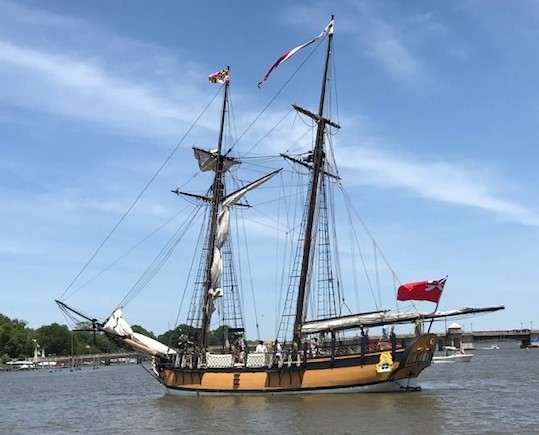Chestertown, Maryland sits along the Chester River on the northern part of the Eastern Shore of the Chesapeake Bay. I’d read about it but my travels always took me south on the Eastern Shore… to Easton, Cambridge, St. Michaels. During Covid I finally explored the colonial town, home to Washington College, chartered in 1782 and the first college founded after American independence. It’s a gem of preservation and small-town goodness.

Last week a friend invited me to join her at the Chestertown Tea Party reenactment, an annual event on the town’s calendar. It commemorates the day in May, 1774, when Chestertown residents decided to copy Boston and have a tea party of their own to protest British excise duties. The tall ship Sultana docks most of the year in Chestertown and for the reenactment doubles as the British merchant ship Geddes, the ship that became the target for Chestertown’s ire.
I didn’t know what to expect, but as a good historian, did a little research prior to my trip. I’d heard about other tea parties in east coast towns (Annapolis, Yorktown, Wilmington, Charleston…) but I’d never heard about Chestertown’s protest. Then I noticed the word Legend, a word that intrigues every historian. Every historian wants to debunk myths and discover truth to legends. Many towns pride themselves on notable events from their past that lack evidence, but are a great story.

According to the Chestertown legend, the members of the local chapter of the Sons of Liberty were outraged by the taxes on tea and local leaders adopted the Chestertown Resolves, making it unlawful to buy, sell, or drink tea from England. When word came that a recently arrived ship held tea, a small group of men forcibly boarded the ship and threw the tea into the river. Unlike in Boston, this event supposedly occurred in daylight and the men wore no disguises. In 1968 the town staged its first tea party reenactment, and most every year since the nation’s bicentennial in 1976. This patriotic feel-good event brings the community together.

https://libapps.salisbury.edu/nabb-online/exhibits/show/voices/the-great-leap/chestertown-tea-party–fact-or
And yet… I’m thrilled when a town wants to celebrate its past in such a public way – with a parade, street fair, and a reenactment. But… the only problem is there is no contemporary documentation the event happened. The Resolves were printed in the Maryland Gazette, but no notice about the tea party exists in the Gazette or any other colonial paper. The first mention of it in the historical record is not until 1899 and that record does not cite a source. No other sources have been uncovered over the years. Researchers have been able to verify that the ship Geddes, built in Chestertown, was in the area during the right time. Whether or not she held tea has not been documented.



The day dawned sunny and perfect and my friends and I enjoyed the festival. Just before show time, we walked out to the dock to see the ship, but it was pulling away from dock to be in place for the show. So we stayed out on the dock, only sixty or so feet from the action. Surrounded by locals, I asked them about the reenactment and they fully acknowledged it’s based on legend. Unfortunately, while we avoided the crowds on shore, we missed the narrative explaining the events that led up to the point where “townsmen” jumped in a row boat and rowed out to the ship. The ship’s small cannons boomed in warning. Just then, to our disappointment, the wind shifted and the ship moved slightly to block our view of the action. The men climbed on board somehow and then the mock fighting began. We could see exaggerated fists pummeling the air — a contactless brawl. Then one by one the big boxes clearly marked TEA were hurled overboard to the cheers of the audience. The women near me said it used to be more fun when the colonists could throw the British soldiers into the river, too, but they said the Coast Guard no longer allows this. The watchful eye of a Coast Guard cruiser lurked nearby.
When the last box of tea had been chucked into the river, the large British Red Ensign flag waving in the wind at the stern was lowered, and replaced with a stars and stripes flag (which of course didn’t exist in 1774 because the United States did not exist then – but a small inaccuracy!) Patriotic Americans on shore cheered.

I had a fun time, steeping (couldn’t resist) in history that may or may not have taken place. I’m always happy when a town commemorates its past – as long as it acknowledges a legend. No doubt many of the people who came to the festival and ran in the races and marched in the parade think the event actually happened. But the spirit of historic protest and good fun seemed to bring a community together, so that’s a good thing. Right? It’s good anytime the public is encouraged to focus on history!
What do you think?
Related posts

